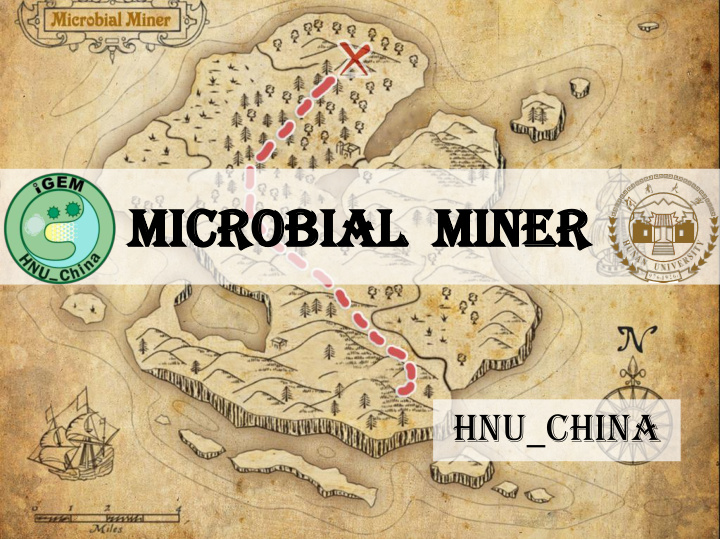



Mi Micr crobial obial Mi Miner ner HNU_China
Let’s start to find the treasure!
Background 1. Introduction • Biomining: utilize microorganisms to extract and recover metals from ores and concentrates. • Advantages of Biomining – Energy conservation – Emission reduction
Background 2. Application of Microorganisms • Work in consortium • Metal dissolution: ─ Iron oxidizer: to generate ferric iron, the main oxidant of sulfide mineral. • Acid mine drainage remediation - Absorption of metal
Background 3. Strategies for better biomining microorganisms • “top down” approach – Inoculate a mixture of microorganisms into the reactor and screen for the better microbial consortium. • “bottom up” approach – Construct a "logically designed" consortium to leach a particular ore with certain defined microorganisms.
Background 4. Synthetic biology-the future of Biomining • Consortia consisting of genetically engineered microoganisms have not been reported so far. - Inefficiency in transformation - Difficulty in genetic manipulation • Once more suitable transformation protocol developed, it may be feasible to genetically engineer microbes. - Attenuate or amplify natural or artificial signals.
Our Project 1. Aim: c reate a "Microbial Miner " • A genetically engineered yeast strain that can sense, oxidize and absorb iron with high efficiency • Introducing a blue light-controlled apoptosis system into the yeast so that unwanted transgenic yeasts can be easily destroyed
Our Project 2. Iron sensing and absorptive system • FET3 ‒ Saccharomyces cerevisiae ‒ High affinity iron uptake ‒ Facilitate iron uptake by catalyzing the oxidation of Fe(II) to Fe(III) by O2, shown as below: 4Fe(II) + O2 + 4H+ → 4Fe(III) + 2H2O
Our Project ─ In Saccharomyces cerevisiae, FET3 and FTR1 proteins assemble into a complex in the plasma membrane for iron transport. ─ High iron leads to the internalization and degradation of both FET3 and FTR1.
Our Project 2. Iron sensing and absorptive system • IRE- IRP1 ‒ Human cell ‒ Ferritin ‒ Interactions between iron regulatory protein 1 (IRP1) and iron responsive elements ( IRE ) in ferritin mRNA
Our Project ─ Decreased iron supply activates the binding of IRPs to IRE, which results in the translational inhibition of ferritin. ─ High iron conditions decrease the binding affinity of IRPs to IRE, release the translational inhibition. As a result, ferritin protein level is increased.
Our Project 2. Iron sensing and absorptive system
Our Project 3. Opto-apoptosis system • Apoptosis - Caspases: a family of cysteine proteases that play essential roles in apoptosis - Yeasts lack some elements of the complex apoptotic machinery - Caspase-8: over-expression lead to cell death - Caspase-3: over-expression lead to retarded cell growth.
Our Project 3. Opto-apoptosis system • Apoptosis - In our design, the apoptosis related protein expresses when exposed to the blue light. - Leaky expression is expected. - Biomining environment is typically harsh for the yeast. - Choose the less toxic caspase-3.
Our Project 3. Opto-apoptosis system • CRY2-CIB1 - Cryptochromes (CRY): photolyase-like blue-light receptors that mediate light responses in plants and animals. - CIB1: from Arabidopsis , only interacts with CRY2 (cryptochrome 2) under blue light condition. - Enable light-controlled gene expression in mammalian cells.
Our Project 3. Opto-apoptosis system • Split Gal4 - GAL4 BD: the binding domain of a transcriptional factor GAL4, oriented to upstream activating sequence (UAS) in the promoter. - GAL4 AD: the activating domain of GAL4, it can recruit other transcription factors to initiate gene transcription.
Our Project 3. Opto-apoptosis system
Experiment Results 1. Gene cloning • IRP1 and CASP3 are cloned from existing human cDNA library. • CRY2 , CIB1 are cloned from existing Arabidopsis cDNA library. • FET3 is cloned from the Saccharomyces cerevisiae genome. • IRE is made by annealing two complementary single- stranded DNA oligos and then cloned into the pMD- 18T vector.
Experiment Results 2. Optogenetic yeast-two-hybrid • CRY2 and CIB1 are cloned into the commercial shuttle vectors, pDEST32 and pDEST22. • Both of the pDEST22- CIB1 and pDEST32- CRY2 are transformed into the Saccharomyces cerevisiae strains AH109.
Experiment Results SD/-His-Leu-Trp+3-AT • A proof of principle experiment to show that by using our optogenetic system we can induce the expression of β - galactosidase with blue light.
Future Work • Verify the apoptosis effect of caspase-3. Alternative design: caspase-8. • Determine the kinetics of the iron sensing and absorptive system. • Integrate two systems into one.
Human Practice The Open Source Innovation and Intellectual Property Protection in iGEM An small article (in Chinese) that introduces iGEM to our community and discusses the relevant Intellectual Property Rights Protection issues in China.
Team
Summary
Iron Sensor Iron Oxidizer Iron Absorber Biosafety
Acknowledgement Xiaoxiao He Yaohong Gao Xuanming Liu, Xiaoying Zhao Zheng Zhou College of Biology, Hunan University Feng Yu Hongtao Qin Sponsors: Panpan Feng, Hunan Ruilikai scientific Yuchong Peng, instruments equipment co., LTD Li Li, Long Wang Changsha Kenji technology Bin Li development co., LTD Chiyu Li
Thanks for your attention!
Recommend
More recommend